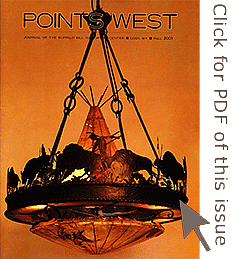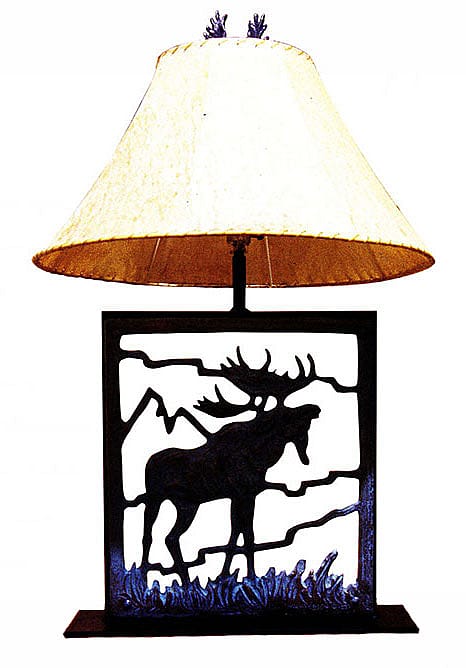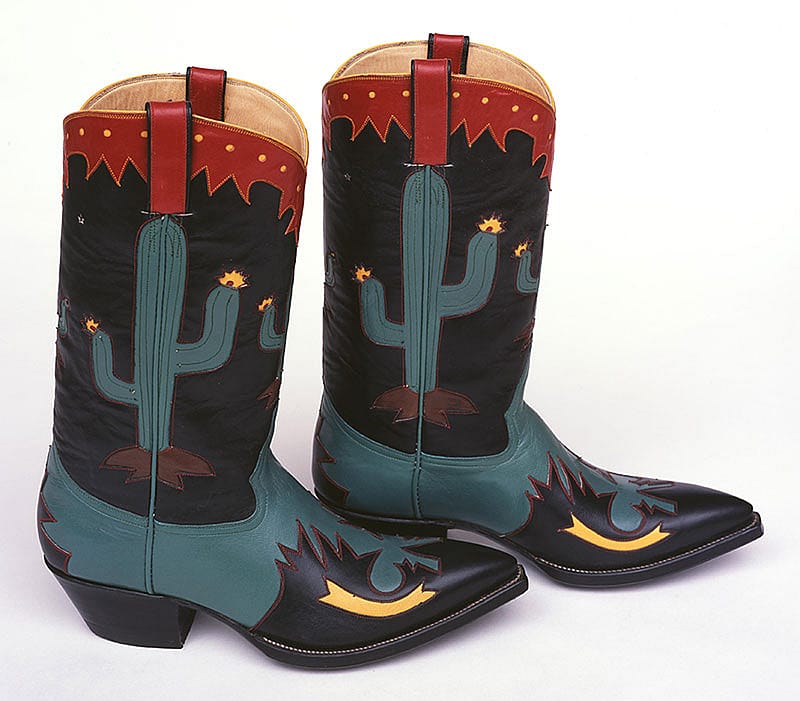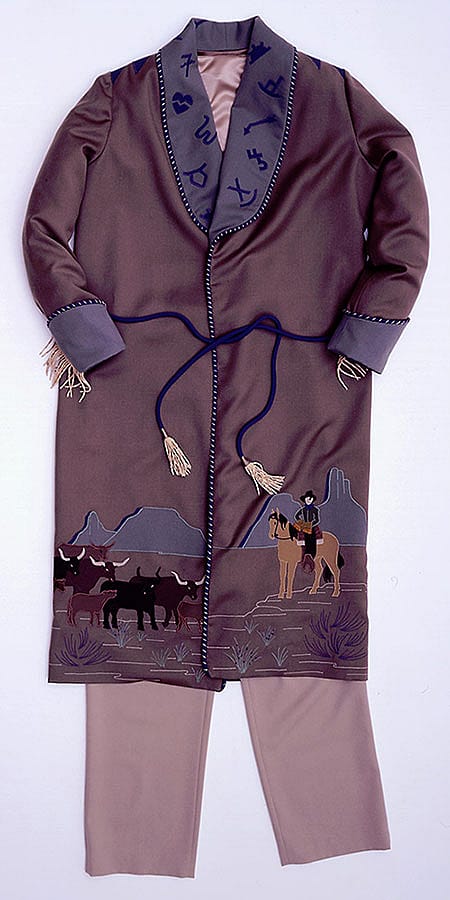!["Daybed" (1998) by Custom Leather and Saddlery, Bartlesville, Oklahoma. [Please note, image in print magazine was split across a two-page spread; alignment here slightly flawed.] 1.69.5754](https://centerofthewest.org/cdn-cgi/image/width=800,height=434,fit=crop,quality=80,scq=60,gravity=auto,sharpen=1,metadata=none,format=auto,onerror=redirect/wp-content/uploads/2018/09/PW212_daybed-1.69.5754.jpg)
Cody Style – Points West Online
Originally published in Points West magazine in Fall 2001
“Cody Style”
Ed. note: a look back at a 2001 exhibition of western decorative arts, which have ties to By Western Hands. Click here to find out more about the organization dedicated to preserving the legacy of western design.
By Barbara Foote Colvert
Guest Author
Cody western style may have been firmly rooted in the imaginations of Thomas Molesworth and Charles Bohlin, but it by no means ends with them. It is a vital, dynamic presence in Yellowstone Country today. A temporary special exhibit titled Cody Style: a Western Decorative Arts Tradition, designed and curated in 2001 by Wally Reber, Associate Director of the Buffalo Bill [Center of the West] at the time, highlighted the style.
Functionality and serendipity mark the evolution of the works shown in this exhibit of western artists-artisans, with function and form celebrating the vagaries of Mother Nature. Multiple materials are incorporated with precision and artistry, with freer adaptations coming to the fore in the modern pieces.
The exhibit began with the creations of Thomas Molesworth, which show the distinct influence of the Adirondack rustic style.[1] Reber distinguishes this interpretation of the Adirondack artisans, however.
“Molesworth worked not in twigs and not in the assembly of twigs into intricate and artful shapes, à la Adirondack twig mosaic. He worked in flat-sided pieces, slab-sided, some with pine pole and leather trim, some with routed side panels, some with painted relief, and some woven,” he states.
Using a “slab-sided” application of wood—that is, wood pieces planed on one side and adhered in vertical strips to the side panels—enforces the vertical lines in many of the pieces produced by Molesworth’s Shoshone Furniture Company in Cody, Wyoming.
The pine “Armchair” (1930), with burl arms and leather cushioning, is upright and sturdy. It is made for sitting and it will last and last. The famous “Horse Head Bed” (1942) [see this work, and one of the keyhole chairs mentioned in the next paragraph, in the article Cowboy Style] also uses the slab-sided wood application with a stylized carving of the horse head on the headboard.
“Three Keyhole Chairs” (1940) offer a classic throwback to the Arts and Crafts Movement with simple, sturdy lines. The “Overstuffed Armchair” (1950) features the use of turned fir pole legs, and the chimayo cushions that distinguished Molesworth’s upholstered chairs and footstools. Leather trim secured with brass studding and woven leather sides also show Molesworth’s favorite adaptation of materials.
The exhibit took a graceful leap from these classics of the 1930–1950s era to the very modern “Foosball Table” (1996) created by Triangle Z Ranch Furniture, Cody, Wyoming. The transition here is seamless, and it is obvious that these designers are having fun with material and style. Employing the classic twig application, sturdy pine legs and leather accents give this modern adaptation a sense of whimsy.
Across from this piece was the “Cabinet” (1995) designed by Red Bird Furniture, Dubois, Wyoming. lt charmingly echoes Molesworth’s conservative line and artistry, with delightful contemporary accents such as the antler drawer pulls, and the chunky, burl cross piece that joins the legs.
The “Corral Creek Sideboard” (1994) by Covert Workshops, Cody, Wyoming, catches the eye with purity of line and expert adaptation of Molesworth’s style. But this is no 1930s construction. Beyond the classic use of twig application, whimsy takes hold. The legs are noticeably flared, a clear departure from Molesworth’s verticality that celebrates the natural growth of the legs. Mother Nature has definitely been welcomed into this design that employs multiple woods—walnut, juniper, cedar, driftwood, fir, pine, and lodgepole—combined in elegant patterns. Burl drawer pulls and a covering for the top of water buffalo hide make stunning finishing touches.
!["Corral Creek Sideboard" (1994) by Covert Workshops, Cody, Wyoming. Photo by Devendra Shrikhande. [Please note, image in print magazine was split across a two-page spread; alignment here slightly flawed.] From the 2001 exhibition Cody Style. 1.69.4881](https://centerofthewest.org/cdn-cgi/image/width=900,height=721,fit=crop,quality=80,scq=60,gravity=auto,sharpen=1,metadata=none,format=auto,onerror=redirect/wp-content/uploads/2018/09/PW212_dresser.jpg)
Another stunner in this exhibit was the breathtaking “Teton Setee” by John Gallis, Cody, Wyoming. This sensuous piece celebrates the meandering growth and coloration of the walnut used in the frame perfectly complemented by supple leather cushioning. In a short video presentation that accompanies the “Cody Style” exhibit, Gallis heralds the marriage of style and usage, saying that good design should be “functional and practical and tell a story…the more you look the more you see.” Gallis has triumphantly succeeded with his ultra modern settee that is destined to become a classic in its own time.
The “Anti Gravity Table” (1998) by New West Furniture, Cody, Wyoming, is sure to become a classic of western design. For sheer style and function, this piece is utterly flawless. The top, made of planed burl, is affixed to a base of whorled, red cedar. It indeed defies gravity in a simple “C” curve that works elegantly, simply, and with breathtaking purity of purpose. This perfect marriage of whimsy and class says it all about western design today.
The pure artistry of the “Sky King Table” (1999) by Mark Koons, Wheatland, Wyoming, confirms this designer’s mastery as a designer technical craftsman. An intricate laminate employing a variety of woods celebrates the tonal and textural differences of box elder, cherry, birds eye maple, mulberry, lilac, and sassafras.
This is the work of a grand master in complete command of material and design. It is accented perfectly by the “Moose Lamp” (1995), by John Mortensen, Wilson, Wyoming. The bronze moose topped with a rawhide shade embody pure elegance and simplicity in western design.
The “Occasional Table” (1997) by Quandary Design, Leadville, Colorado, sneaks up on the viewer with the sturdiness of a Molesworth classic interpreted with a contemporary use of Utah juniper, burl, redwood, and tooled leather.
The most daring example of a contemporary western look is represented in the “Daybed” (1998) by Custom Leather and Saddlery, Bartlesville, Oklahoma. There is practicality in its conversion capability from daybed to full-size bed. From there the designers have clearly had a ball. Materials are combined with elegance and panache, beginning with an eye-catching hide “coverlet.” A generously proportioned leather border is hand-tooled using a rich floral pattern. Multiple steer horns form a railing along the back of the daybed and are also used as legs. A skirt of creamy suede fringe lends a final touch of elegance to this piece that is gloriously western.
!["Daybed" (1998) by Custom Leather and Saddlery, Bartlesville, Oklahoma. [Please note, image in print magazine was split across a two-page spread; alignment here slightly flawed.] 1.69.5754](https://centerofthewest.org/cdn-cgi/image/width=1080,height=586,fit=crop,quality=80,scq=60,gravity=auto,sharpen=1,metadata=none,format=auto,onerror=redirect/wp-content/uploads/2018/09/PW212_daybed-1.69.5754.jpg)
In creating the Cody Style exhibit, Wally Reber carefully showcased the masterful work of Edward H. Bohlin, “Saddle Maker and Silversmith to the Stars.” The “Bohlin Saddle and Accessories” of black leather with complimentary tack, and matching pair of black leather wingbat chaps with silver ornamentation are the epitome of classic western design. No wonder Bohlin’s work attracted the attention of Hollywood’s western elite!
Accessory items follow within the exhibit, including Bohlin’s elegant tri-color belt and buckle sets and trophy rodeo buckles, bolas, and a silver Bohlin hatband, the perfect complement to the Seven Beaver Stetson hat with a classic Montana peak owned by Charles Belden. Clothing items within the exhibit are a direct throwback to items carried in the western clothing section of Bohlin’s catalog, “The Western Shop.”
The “Purple Sage Smoking Jacket” (1997) by Anne Beard of Heppner, Oregon, exudes soft, subtle shades of sage, purple and tan colors indigenous to the western landscape. Appliqued western images lighten the look of this elegant garment. Designers at Rocket Buster Boots must have had a good time fashioning “Cowboy Boots” (1994) using a colorful cactus motif against a black night sky sprinkled with stars.
One of the most elegant accessory items in the exhibition is the “lndian Box” (1996) by Judy Nansel and Julie Powell, Bozeman, Montana. These designers have demonstrated great skill and imagination fashioning a twig mosaic, carried a step farther with a delicate pattern hand-carved into each piece. This work resonates with a rich Oriental look that leaps across time and culture with imagination and style.
Imagination and style. These qualities distinguish the Cody Style of yesterday and today. The adaptations displayed in this exhibit offer a sampling of western art and design that are as rich with possibility as Mother Nature herself, and guarantee connoisseurs the world over pleasure and enrichment for years to come.
Note:
[1] Fees, Paul and Wally Reber. Interior West: The Craft and Style of Thomas Molesworth, Buffalo Bill Historical Center, Cody, Wyoming 1989.
Written By
Nancy McClure
Nancy now does Grants & Foundations Relations for the Center of the West's Development Department, but was formerly the Content Producer for the Center's Public Relations Department, where her work included writing and updating website content, publicizing events, copy editing, working with images, and producing the e-newsletter Western Wire. Her current job is seeking and applying for funding from government grants and private foundations. In her spare time, Nancy enjoys photography, reading, flower gardening, and playing the flute.














